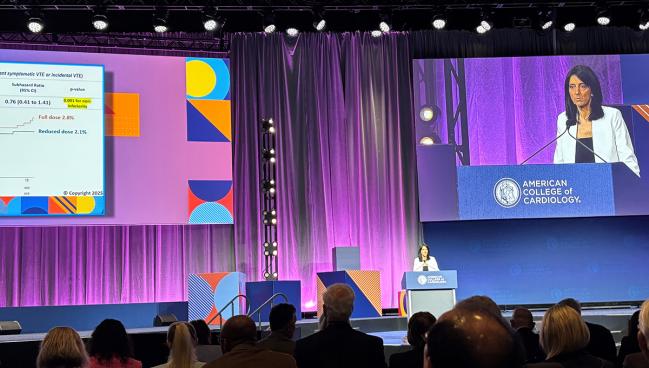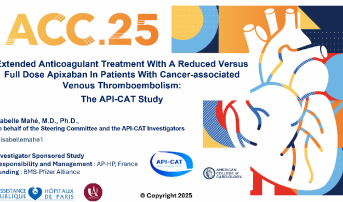Low-Dose Apixaban Prevents Recurrent VTE in Cancer Beyond 6 Months: API-CAT
(UPDATED) On top of noninferior efficacy, the trial showed patients had less bleeding with 2.5 mg vs 5.0 mg twice daily over 12 months.

CHICAGO, IL—For patients with active cancer who’ve had venous thromboembolism (VTE), 12-month extended anticoagulation with reduced-dose apixaban is noninferior to the full dose at preventing recurrent VTE, according to data from the API-CAT trial.
The lower dose of 2.5 mg twice daily also resulted in fewer clinically relevant bleeding complications than the 5.0-mg twice-daily dose, researchers report. The findings were presented Saturday at the American College of Cardiology (ACC) 2025 Scientific Session and simultaneously published in the New England Journal of Medicine.
Lead author Isabelle Mahé, MD, PhD (Assistance Publique–Hôpitaux de Paris, Université Paris Cité, Colombes, France), in an ACC press conference, told journalists that international guidelines support giving 6 months of anticoagulation, most often with a direct oral anticoagulant (DOAC), after a cancer patient initially develops VTE. Therapy should then continue for as long as the cancer remains active or is being treated.
But what should happen beyond 6 months hasn’t been clear. Recurrence risk decreases—but doesn’t disappear—after that window, “whereas the risk of bleeding remains substantial” with anticoagulation, Mahé said. This trade-off has become increasingly relevant because “the life expectancy of patients with cancer-associated thrombosis is improving.”
API-CAT was designed to test whether a lower dose of apixaban could continue to be protective while blunting the bleeding risk posed by the drug, Mahé explained. Based on what they found, she said, guidelines should be changed to address the best approach to extended anticoagulation in this population.
Diego Sadler, MD (Cleveland Clinic Florida, West Palm Beach), who discussed the findings during the media briefing, agreed the study is likely to change practice. “This is excellent news for cardiologists and oncologists,” he said. “This impacts a large population: just in the United States, there are 2 million new active cancers each year and 20 million cancer survivors. A lot of these patients have a high incidence of embolic events, and they struggle with a high risk of bleeding.”
Sadler told TCTMD that some clinicians have probably already been trying the 2.5-mg dose in real-world practice. “When [you] have patients with high bleeding risk, sometimes you compromise: you go lower dose,” he said. Thanks to API-CAT, “we now know . . . that what we’re doing this right.”
The data are quite meaningful, Sadler explained. “These are patients that used to die,” he said, but with today’s immunotherapy, people with stage 4 cancer “can stay alive for 5, 10 years or more, and those patients may be on anticoagulants the rest of their lives. It’s very important that now we have data to support the continuous low dose.”
API-CAT
API-CAT researchers enrolled 1,766 patients (median age 69 years; 56.6% women) with active cancer and proximal deep vein thrombosis or pulmonary embolism who’d been on at least 6 months of anticoagulant therapy. Patients were randomized in a double-blind fashion to receive 2.5 mg or 5 mg apixaban (Eliquis; Bristol Myers Squibb) twice daily for 12 months. The median time between the index VTE and enrollment was 8.0 months.
Over a median treatment time of 11.8 months, the primary endpoint of centrally adjudicated fatal or nonfatal recurrent VTE occurred at a cumulative incidence of 2.1% in the reduced-dose group and 2.8% in the full-dose group. This met the trial’s criteria for noninferiority, thanks to the upper boundary of the adjusted subhazard ratio’s confidence interval falling withing a margin of 2.00 (adjusted subhazard ratio 0.76; 95% CI 0.41-1.41; P = 0.001 for noninferiority).
Clinically relevant bleeding (adjudicated major or clinically relevant nonmajor bleeding), which was assessed for superiority, occurred in 12.1% of patients assigned to 2.5 mg apixaban and 15.6% of those assigned to 5.0 mg apixaban (adjusted subhazard ratio 0.75; 95% CI 0.58-0.97; P = 0.03). Mortality rates were statistically similar between the two study arms, at 17.7% and 19.6%, respectively.
The researchers acknowledge several limitations of their study: lack of guidance on what should happen beyond 12 months of extended therapy, no details on variations among various racial/ethnic groups, and exclusion of patients with brain tumors. As a follow-up, they intend to delve into the data based on what type of cancer patients had and try to tease out the determinants of bleeding, according to an ACC press release.
Discussant Bonnie Ky, MD (Penn Medicine, Philadelphia, PA), following Mahé’s presentation, described API-CAT as “truly seminal” study set to change practice. “We know that cancer significantly increases the risk of VTE,” she said, noting that although recurrent VTE rates have decreased over the past few decades, bleeding rates have increased. “This supports the significance of the question you addressed.”
“I need all of the cardiologists and care providers here—the whole CV team—to know this: there have been substantial advances in cancer treatment and improved survival,” such that active metastatic cancer “is increasingly becoming a chronic disease,” said Ky. “We need to mitigate these comorbid conditions that impact this growing population.”
Simon Nobel, MD (Cardiff University, Wales), in an accompanying editorial, praises the API-CAT investigators for their focus on clinically relevant bleeding. “This factor should be regarded as a strength because it recognizes that in this trial population, in which more than 80% of the patients had an incurable disease, the effect of bleeding on overall quality of life will often take primacy over whether the bleeding is classified as major or nonmajor,” he writes.
Nobel notes that prior research has shown that while so-called nuisance bleeding may “at first glance appear to be of little relevance,” it in fact has “considerable effect on patient distress, activities of daily living, and overall emotional health.”
API-CAT “provides clinicians with much-needed information for them to engage in meaningful dialogue with patients in order to make anticoagulation decisions that are based on patients’ values and preferences,” he concludes.
Caitlin E. Cox is News Editor of TCTMD and Associate Director, Editorial Content at the Cardiovascular Research Foundation. She produces the…
Read Full BioSources
Mahé I, Carrier M, Mayeur D, et al. Extended reduced-dose apixaban for cancer-associated venous thromboembolism. N Engl J Med. 2025;Epub ahead of print.
Noble S. Cancer-associated venous thromboembolism — beyond 6 months. N Engl J Med. 2025;Epub ahead of print.
Disclosures
- API-CAT was funded by the Bristol Myers Squibb–Pfizer Alliance.
- Mahé reports being a speaker for Bayer, Bristol Myers Squibb, LEO Pharma Research Foundation, and Pfizer; receiving a grant from Bristol Myers Squibb; and being on the advisory board of Sanofi.
- Noble reports serving as a speaker for LEO Pharma A/S.






Comments